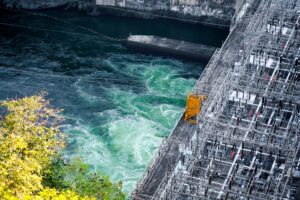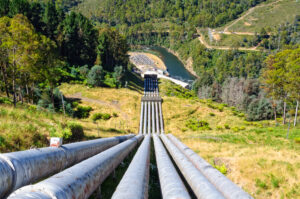Hydropower in the UK: Q&A Session with Fichtner Head of Hydropower UK&I, Tom Clegg
Hydropower is a flexible technology that has a long history in the UK, having first been utilised in 1878 to power a single lamp in Northumberland. Fast forward to present day and the UK now has an installed hydropower capacity of over 4,700 MW, including over 2,800 MW of pumped storage. However, recent studies have shown that hydropower has a much larger potential, and coupled with other renewable technologies, could be a vital steppingstone in the decarbonisation of our electricity system.
In light of the growing interest in pumped storage schemes, we sat down with our UK Hydropower Lead, Tom Clegg, to discuss how hydropower works, technology, and investment across the market.
Q: What is Hydropower pumped storage?
Pumped storage schemes represent the largest batteries on our electricity network. Two reservoirs, one at the top of the hill and one at the bottom are linked by a pipeline. When there is surplus electricity in the grid and power prices are low water is pumped from the lower reservoir to the top. When this energy is required, it is then released from the top reservoir and drives a turbine before returning to the bottom reservoir. The turbine generates electricity which feeds into the national grid. Pumped storage is very mature technology with examples on the UK nation grid providing reliable service for over 50 years.
Q: How does pumped storage work as part of the electricity system?
Schemes often have a rated capacity of several hundred megawatts and the capability to pump or generate at this capacity for many hours. Pumped storage schemes can be very quick to respond (within 10 seconds at the fastest) and offer excellent round trip energy efficiencies. In our future energy network a large amount of intermittent wind generation is expected. Pumped storage has the scale and capacity to smooth the peaks in wind generation and release this energy when required into the national grid.
Q: What are the latest advances in pumped storage technology?
The technology most of our clients wish to discuss is Variable Speed. Traditional pumped storage schemes are limited in only being able to pump at rated power. Variable speed enlarges the operating envelope to provide further flexibility. Start-up times can also be significantly reduced on a variable speed unit. This comes at the penalty of additional capital costs and space requirements for the converter equipment.
Another interesting innovation is Hydraulic Short Circuit (HSC). This is where adjacent pump/turbines are run in the opposite modes (i.e. one pumps while the other generates). This allows the station as a whole to deliver energy generation or storage at other operating points then simple operation of the units. This requires careful waterway design and comes at an efficiency penalty, but serves to further enhance the flexibility of pumped storage hydropower. I’ll be discussing this in more detail at the annual British Hydropower Conference in September.
Q: Why is hydropower important for the energy transition?
First of all, the UK has some fantastic natural resource for Hydropower with mountainous areas and high annual rainfalls. Hydropower assets once constructed are very robust and capable of many decades of carbon free electricity generation. They provide inertia to the national grid and schemes with the capability to store water are dispatchable to meet energy requirements at peak times. Additionally, Hydropower pumped storage is one the most mature energy storage technologies available and will be very important as part of the future energy strategy for the UK.
Q: Are investments in hydropower increasing?
Currently there is a great deal of interest in the market in developing pumped storage schemes. We are supporting a number of clients in the project development of schemes. Hopefully these schemes will be delivered into fruition. It certainly looks like pumped storage has a bright future as a significant part of the UK energy storage mix.
















